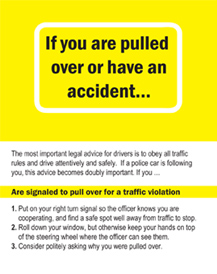Car accidents — Initial evaluation — The burden of proof
The burden of proof is a legal concept that establishes the duty or the amount of proof that a party to a lawsuit must show to prove a disputed fact.
The level of the burden of proof is a critical factor in evaluating how likely it is that your personal injury lawyer can prove that the car accident took place as you claim it did.
General principle
Generally, the burden of proof in a car accident lawsuit is the “fair preponderance of the credible evidence.” This is much less stringent than the burden of proof in criminal cases, which is often “guilt beyond a reasonable doubt.”
Nonetheless, this requirement of the preponderance of evidence requires your personal injury lawyer to convince the jury that the events took place substantially in the manner that you say they did. If the preponderance of evidence does not favor one side or the other, the jury must decide in favor of the defendant.
Sample jury instruction
The following is a sample jury instruction that a judge might give about the burden of proof:
To say that a party has the burden of proof on a particular issue means that, considering all the evidence in the case, the party’s claim on that issue must be established by a fair preponderance of the credible evidence. The credible evidence means the testimony or exhibits that you find worthy of belief. A preponderance means the greater part of the evidence. That does not mean the greater number of witnesses or the greater length of time taken by either side. The phrase preponderance of the evidence refers to the quality of the evidence, its weight, and the effect that it has on your minds. In order for a party to prevail on an issue on which he or she has the burden of proof, the evidence that supports his or her claim on that issue must appeal to you as more nearly representing what happened than the evidence opposed to it. If it does not or if it weighs so evenly that you are unable to say that there is preponderance on either side, you must decide the question against the party who has the burden of proof and in favor of the opposing party.
Exception: reduced burden in cases involving death
Different states have different rules regarding the burden of proof in negligence cases. However, in one state courts have held that the burden of proof is different in wrongful death cases, so that in wrongful death cases the plaintiff need only convince the jury that it is more probable than not that the defendant was negligent and that negligence was a substantial factor causing the deceased’s death.
This reduced burden of proof makes the plaintiff’s case easier to establish.
Exception: reduced burden in cases involving amnesia
Again, different states have different rules regarding the burden of proof, but the courts in one state have held that the burden of proof for a plaintiff who cannot recount the events of the accident because of amnesia caused by the accident is less than the burden of proof for a plaintiff who could remember and describe the car accident. However, to be entitled to this reduced burden of proof the plaintiff must prove by clear and convincing evidence that he or she suffers a loss of memory caused by the car accident.



